Sex of the civil service
This explainer takes a look at sex representation in the civil service.

The sex of the civil service is an indicator of how well it attracts and retains talent. If female employees are less likely to be hired or to progress to senior roles, the civil service is not making the most of its talent pool.
According to the Civil Service Diversity and inclusion Strategy for 2022 to 2025, "a truly diverse workforce and culture of openness and inclusivity" acts as "a means of delivering better outcomes to the citizens we servce."1
The representation of female employees is not only a matter of basic fairness, but also helps government operate more effectively. Antonia Romeo, permanent secretary for the Ministry of Justice (MoJ) and civil service gender inclusion champion, suggests that diverse teams have “a greater breadth of experience and skills” to improve the lives of all citizens.2
What is the current sex representation of the civil service?

In every year since 2001, more than half of all civil servants have been female. This has increased from 49% in 1997, to 55% in 2022. The proportion of female staff in the senior civil service (SCS) has increased from 18% in 1997 to 47% in 2022, just under the benchmark for the economically active population.
How does sex representation vary by seniority in the civil service?
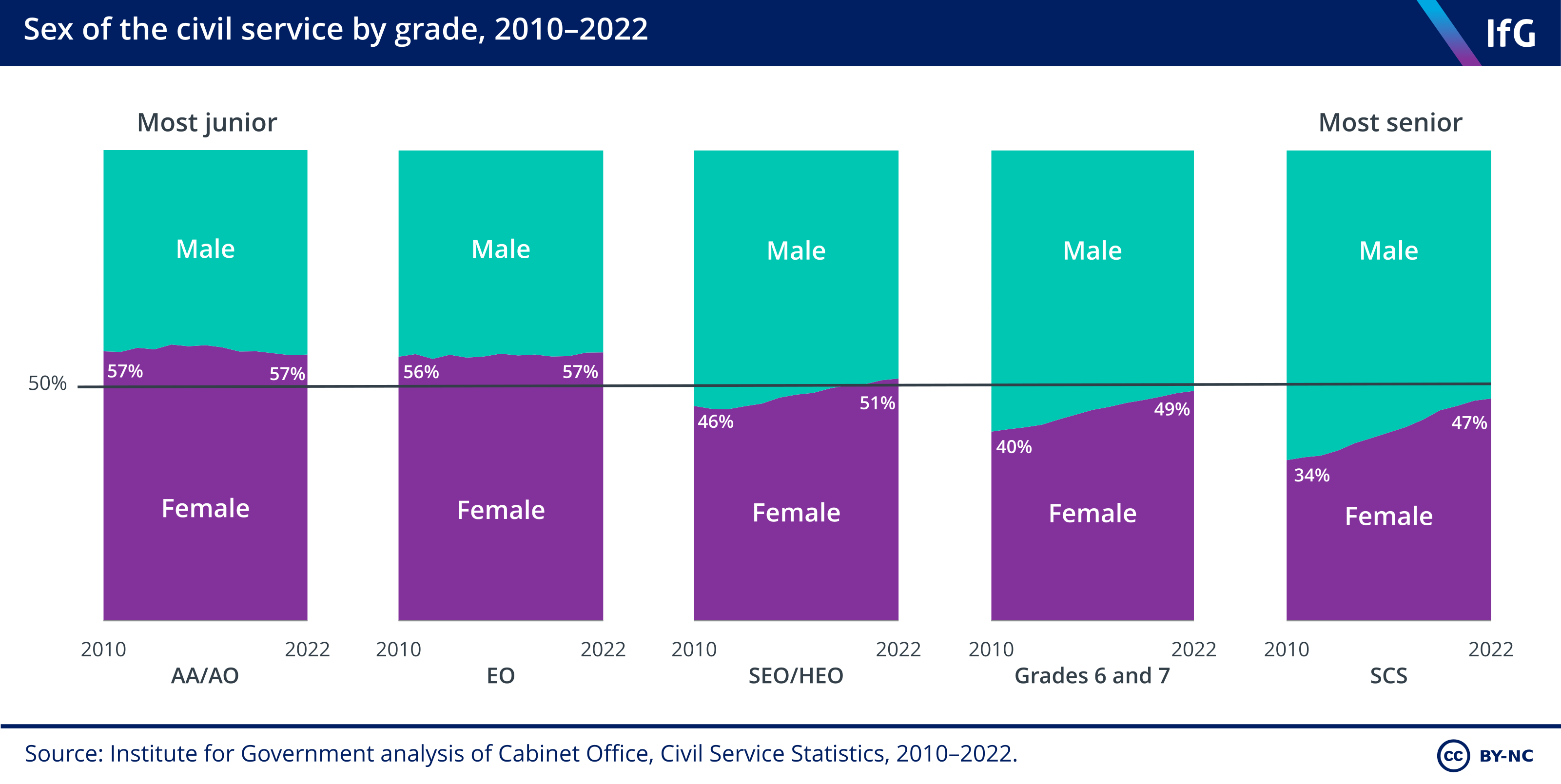
The proportion of female employees has increased or remained flat at all civil service grades since 2010. Female staff make up a higher percentage of junior grades than they do of more senior grades – though they either meet or exceed the working population benchmark at all grades except SCS, and at senior levels the proportion has increased significantly since 2010.
The percentage of female staff has been increasing in more senior grades, suggesting there is now a pipeline of talent to the top. But there is still a blockage to the very top, in terms of permanent secretaries in charge of Whitehall departments.
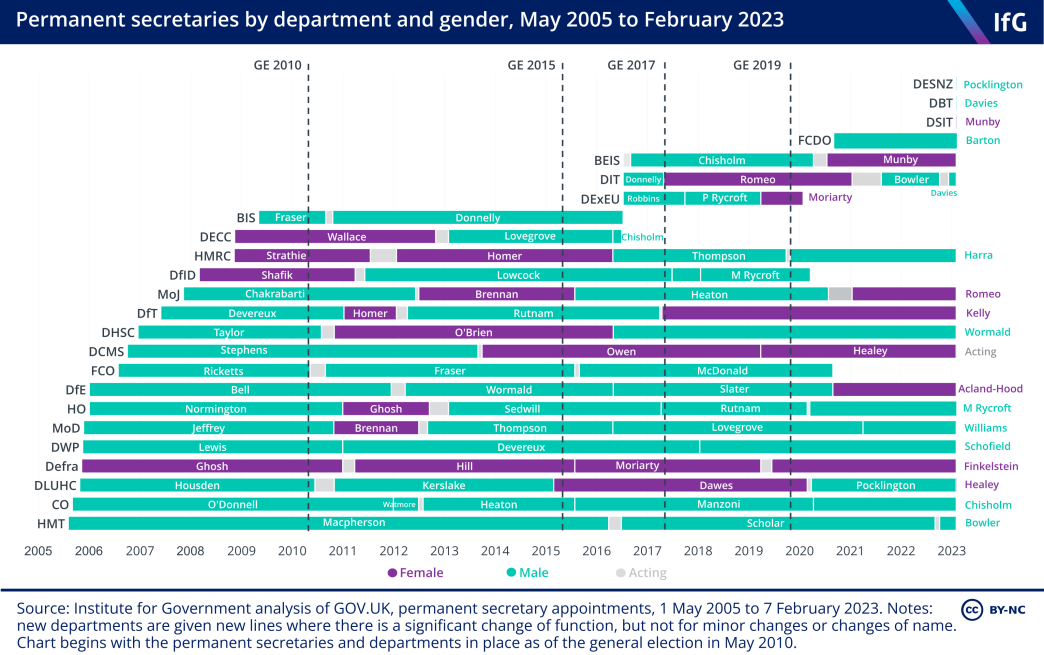
Out of 17 Whitehall departments, only six (35%) are run by women:
- Bernadette Kelly at the Department for Transport (DfT)
- Antonia Romeo at the Ministry of Justice (MoJ)
- Sarah Healey at the Department for Levelling Up, Housing and Communities (DLUHC)
- Tamara Finkelstein at the Department for Environment, Food and Rural Affairs (Defra)
- Sarah Munby at Department for Science, Innovation and Technology (DSIT)
- Susan Acland-Hood at the Department for Education (DfE)
This is more than in May 2010, but down from a peak of eight for half a week in March 2011. Unlike the SCS as a whole, there has been no upward trend in the percentage of permanent secretaries that are women in the last decade.
While the permanent secretaries for the Scottish and Welsh Governments have been women, there has never been a female cabinet secretary.
Despite this, the UK appears to perform well globally. According to the 2019-2020 Women Leaders Index, a study produced by the Global Government Forum and EY, the UK has the third highest percentage of women in the senior civil service among G20 nations, only being outperformed by Canada and Australia.3
How does sex representation vary by government department?
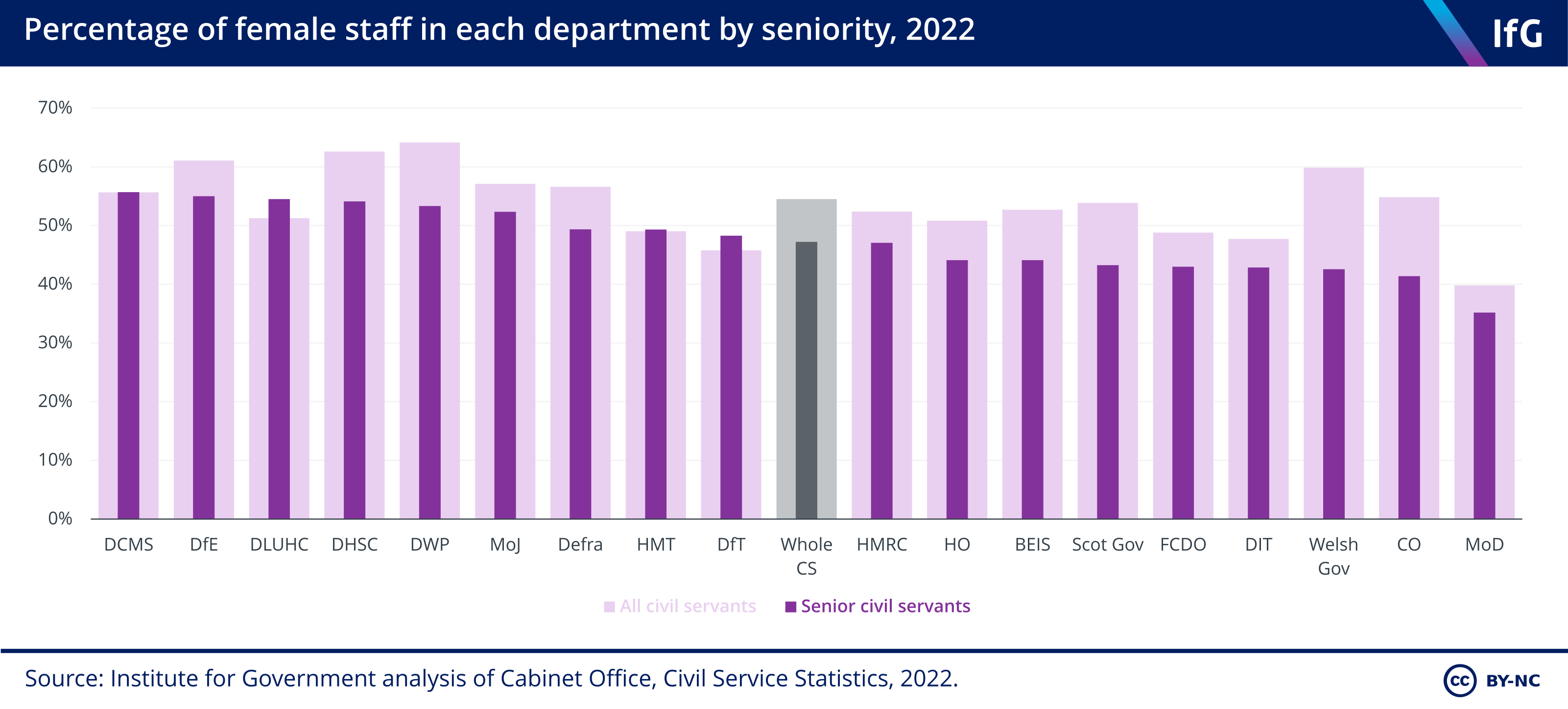
Female staff are underrepresented in SCS positions in the majority of the government departments, reflecting the pattern across the civil service overall.
In six departments female staff make up half or more of the SCS. In four departments – the Department for Levelling Up, Housing and Communities (DLUHC), DCMS, DfT and the Treasury – there is a higher percentage of female employees in the SCS than in the department as a whole.
The departments with the lowest female proportion in the SCS are the Ministry of Defence (MoD) with 35% and the Cabinet Office with 41%.
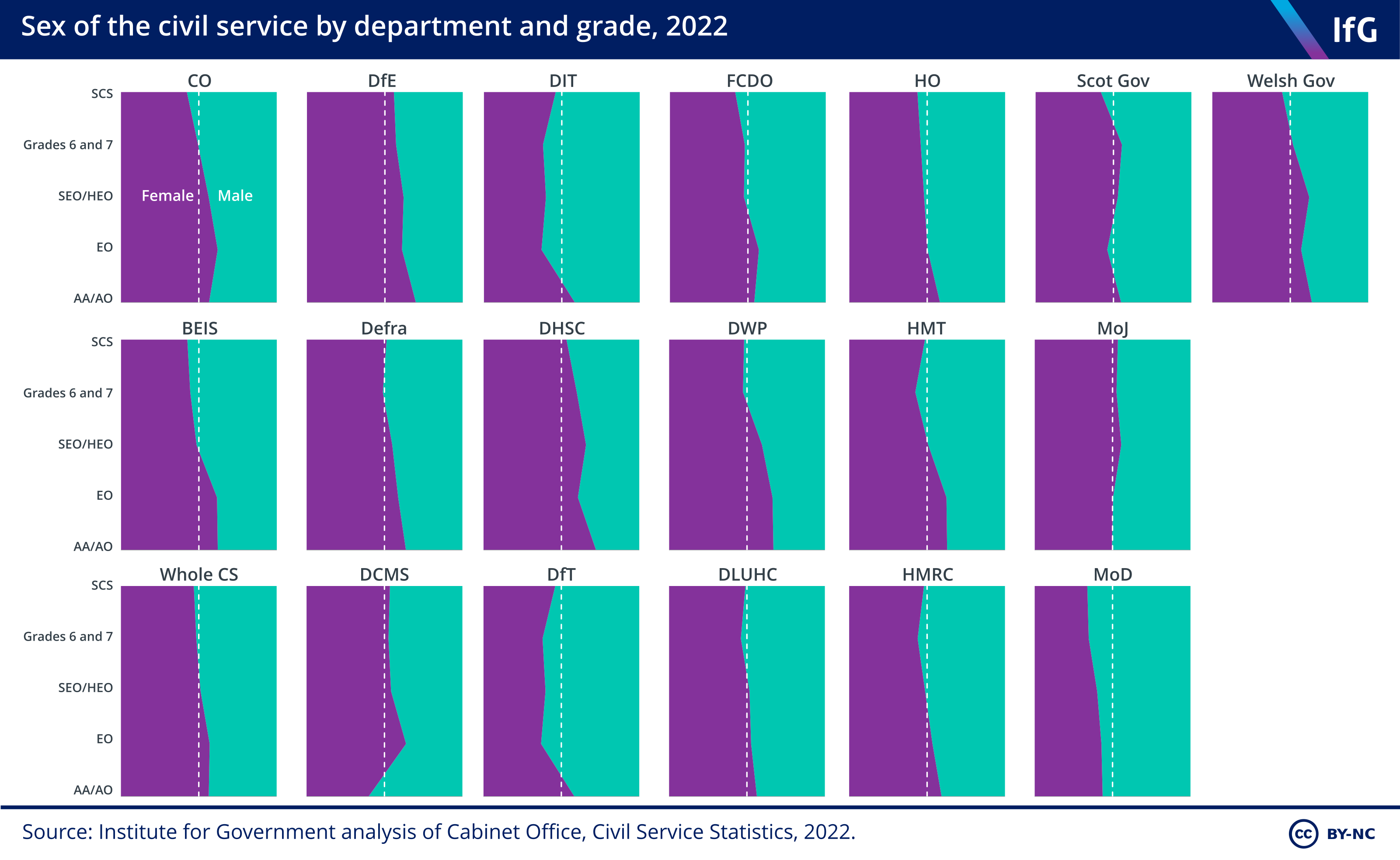
Most departments follow the pattern of the whole civil service when it comes to looking at each grade, with more women at junior grades than senior grades. This is the case for some large departments with significant operational delivery functions such as the DWP, HO and HMRC, as well as policy-focused departments like the Cabinet Office and FCDO.
What is the gender pay gap of civil service departments?
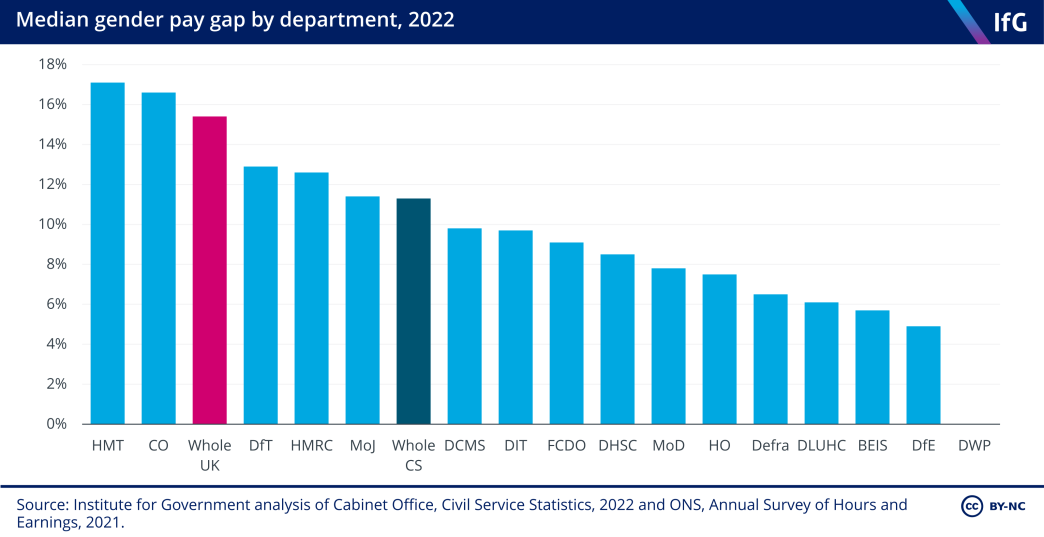
The gap between the median salaries for male civil servants and for female civil servants is 11.3%, below the gap for the whole country – 15.4%. However, the median gender pay gap of HM Treasury (17.1%) and the Cabinet Office (16.6%) exceeds the national average.
At the other end, the median gender pay gap at the DfE is 4.9% and at BEIS the figure is 5.7%. The DWP’s median gender pay gap is 0% because over half of its staff are at the EO grade, most of which are on a ‘spot rate’ salary where all employees within the same grade and pay zone – whether they work in inner London, outer London, or the rest of the UK – are paid the same single rate. The median salaries for male and for female civil servants in the DWP are therefore equal as they both fall within the EO range.4
What has been done to improve sex representation in the civil service?
A number of initiatives have been taken to improve sex and gender representation in the civil service:
- Departmental events to mark International Women’s Day.5
- Better networks, such as the Cross Government Gender Network, a collection of staff networks working towards gender equality in the civil service.6
- The publication of gender pay gap data.7
- A commitment to recognise the impact of menopause in the workplace and actively support women who are affected.8
-
Civil Service, Civil Service Diversity and Inclusion Strategy: 2022 to 2025, 24 February 2022, https://www.gov.uk/government/publications/civil-service-diversity-and-inclusion-strategy-2022-to-2025
-
Romeo A, Update on the gender pay gap - 2019, 24 January 2020, https://civilservice.blog.gov.uk/2020/01/24/update-on-the-gender-pay-gap-2019/
-
Global Government Forum, Women Leaders Index 2019-20, https://www.womenleadersindex.com/
-
Department for Work and Pensions, DWP: gender pay gap report and data 2021, 27 January 2022, https://www.gov.uk/government/publications/dwp-gender-pay-gap-report-and-data-2021/dwp-gender-pay-gap-report-2021#gender-pay-gap-data
-
Civil Service World, ‘We celebrate what we’ve achieved but also commit to going further’: How the civil service marked International Women’s Day, Civil Service World, 12 March 2020, https://www.civilserviceworld.com/in-depth/article/we-celebrate-what-weve-achieved-but-also-commit-to-going-further-how-the-civil-service-marked-international-womens-day
-
Civil Service World, ‘The biggest challenge we’ve faced has been responding to the increase in gender-based violence’: Cross Government Gender Network, Civil Service World, 20 December 2021, https://www.civilserviceworld.com/in-depth/article/cross-government-gender-network
-
Civil Service and Cabinet Office, Civil Service Diversity and Inclusion Dashboard, 10 May 2022, https://www.gov.uk/government/publications/civil-service-diversity-inclusion-dashboard/civil-service-diversity-and-inclusion-dashboard#gender-pay-gap
-
Cabinet Office, Civil Service becomes largest organisation to sign Menopause Workplace Pledge, 7 June 2022, https://www.gov.uk/government/news/civil-service-becomes-largest-organisation-to-sign-menopause-workplace-pledge
- Topic
- Civil service
- Keywords
- Diversity and inclusion
- Publisher
- Institute for Government